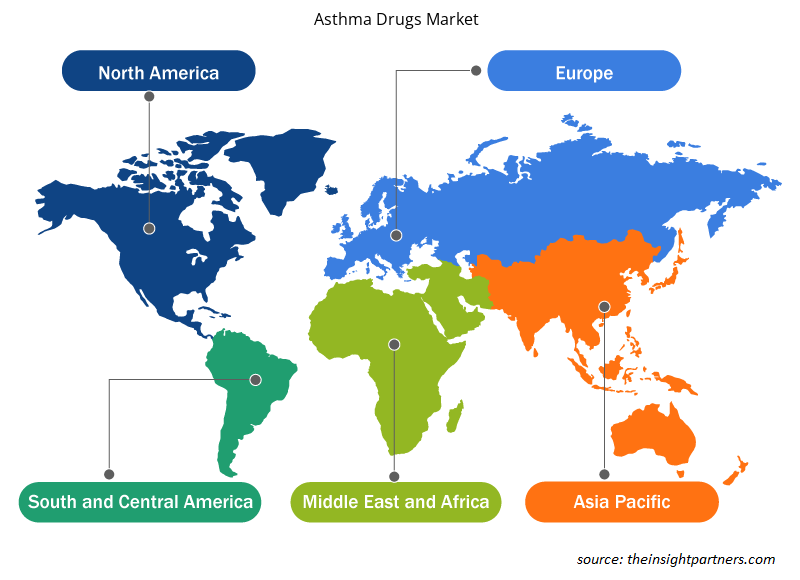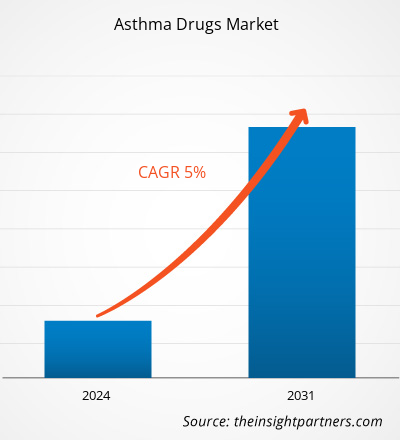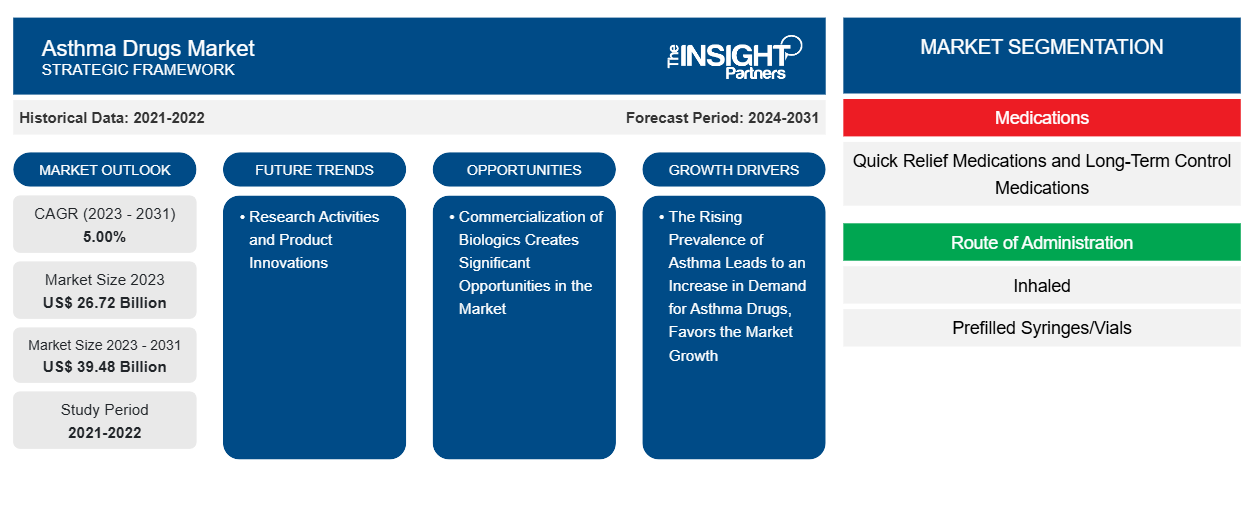哮喘药物市场规模预计将从 2023 年的 267.2 亿美元增至 2031 年的 394.8 亿美元。预计 2023-2031 年期间市场复合年增长率将达到 5.00%。研究活动和产品创新可能仍将是市场的主要趋势。
哮喘药物市场分析
由于污染、生活方式改变和遗传易感性等因素导致全球哮喘发病率不断上升,对有效哮喘治疗的需求急剧上升。药物配方和给药系统的不断创新正在改善患者的治疗效果。由于针对特定分子途径的生物制剂的发展,重症哮喘患者现在拥有更加个性化和有效的治疗选择。由于快速的城市化、意识的提高和医疗基础设施的改善,亚太地区、拉丁美洲和非洲部分地区等新兴市场具有很大的增长前景。这些地区医疗服务的普及和可支配收入的增加也支持了市场扩张。
哮喘药物市场概况
现代吸入器技术,例如具有数字健康功能的智能吸入器,可提高用药依从性,并为更好地管理哮喘提供宝贵信息。医疗保健提供者培训的改善、患者教育计划和提高人们对哮喘及其管理认识的公共卫生运动推动了对哮喘药物的需求。因此,由于对治疗哮喘的药物需求不断增长,市场可能会增长。由于有利的监管框架和新颖和有创意的哮喘治疗的快速审批程序,市场正在增长。提高哮喘管理和护理标准是政府和监管机构越来越关注的另一个领域。
定制此报告以满足您的需求
您可以免费定制任何报告,包括本报告的部分内容、国家级分析、Excel 数据包,以及为初创企业和大学提供优惠和折扣
-
获取此报告的关键市场趋势。这个免费样品将包括数据分析,从市场趋势到估计和预测。
哮喘药物市场驱动因素和机遇
哮喘患病率上升导致哮喘药物需求增加,有利于市场增长
慢性哮喘是一种呼吸道疾病,其特征是气道炎症、支气管高反应性和可变气流受限。根据 Tiotiu 等人撰写的一篇题为“空气污染对哮喘结果的影响”的评论论文,空气污染阻碍了成人和儿童哮喘的结果。交通相关的空气污染、二氧化氮 (NO2) 和二手烟 (SHS) 是儿童哮喘发展的重要风险因素。接触外部污染会导致哮喘症状、病情加重和肺功能下降。在美国,哮喘和接触空气污染仍然息息相关。超过 2300 万美国人患有这种严重的、可能致命的慢性呼吸道疾病。患有哮喘的人可能会因空气污染加剧症状而发作。污染对患有哮喘的儿童构成特别威胁,美国约有 600 万儿童患有哮喘。斯坦福大学儿童中心的研究人员研究了空气污染对高污染地区儿童免疫耐受性相关的两个基因的影响。他们发现,这两个基因的变异会导致哮喘,而接触高浓度的一氧化碳 (CO)、NO2 和 PM2.5(颗粒物)与这些基因的短期和长期变化有关。预防性哮喘药物的开发可能受益于这些发现,这些发现集中于接触空气污染的表观遗传效应。每一项关于哮喘的研究都增进了我们对儿童哮喘的了解,并为 EPA 提供了重要数据,可用于保护人类健康和环境。这些研究项目加速了哮喘药物的发现和开发,推动了哮喘药物市场的发展。
生物制剂商业化创造重大市场机遇
许多哮喘患者发现,使用口服或吸入控制药物、避免触发因素以及在症状发作时使用快速缓解吸入器足以控制他们的哮喘。但对于某些人来说,这些药物不足以治疗他们的哮喘。最近,几种被称为“生物制剂”的创新药物获得了治疗中度至重度哮喘的许可。与其他药物不同,生物制剂针对与哮喘有关的特定抗体、分子或细胞。因此,生物制剂被称为精准或定制疗法。生物制剂是一种旨在针对源自活体生物(例如细菌或小鼠)细胞的人类特定分子的药物。哮喘生物制剂针对细胞受体、炎症化学物质和抗体。通过专注于这些分子,生物制剂旨在干扰导致炎症的机制,从而加重哮喘症状。服用常规日常控制药物后仍出现症状的患者将被处方生物制剂。反复入院、急诊就诊或需要口服类固醇治疗哮喘发作都是哮喘控制不佳的迹象。生物制剂的主要好处是减少哮喘发作的次数,从而减少急诊就诊次数、住院时间和口服类固醇的需求。生物制剂的其他好处包括减轻哮喘症状、减少缺勤和缺课,以及降低其他控制药物的剂量。
生物制剂提高了哮喘患者的生活质量。报告显示,某些生物制剂可以帮助重度哮喘患者的肺部更好地发挥作用。目前,奥马珠单抗、美泊利单抗、瑞利珠单抗、贝那利珠单抗和度匹鲁单抗是五种获批的哮喘生物制剂。明确针对 IgE 过敏抗体的抗体是奥马珠单抗。嗜酸性粒细胞亚群是贝伐单抗、美泊利单抗和瑞利珠单抗的靶标。它们参与过敏性炎症。一种名为度匹鲁单抗的单克隆抗体与产生过敏性炎症的两种分子的受体结合。医生会安排筛查测试,例如验血或皮肤点刺测试环境过敏原,以确定哪种生物制剂可能是最有效的哮喘治疗方法。六岁以上的患者可以使用奥马珠单抗。除了瑞利珠单抗外,所有生物制剂均获准用于十二岁以下的患者。年满 18 岁的成年人可以使用 Reslizumab。试验表明,生物制剂通常是安全的,不良反应发生率较低。此外,生物制剂的成本高于其他控制药物;然而,由于需求增加、新生物制剂的发布和大规模生产,这种情况预计会有所改变。
哮喘药物市场报告细分分析
有助于哮喘药物市场分析的关键部分是药物、给药途径和分销渠道。
- 根据药物,哮喘药物市场分为速效缓解药物和长期控制药物。长期控制药物部分在 2023 年占据了最大的市场份额。
- 根据给药途径,市场分为吸入式、预充式注射器/小瓶和其他。吸入式药物在 2023 年占据了最大的市场份额。
- 根据分销渠道,市场分为医院药房、零售药房和在线药房。零售药房在 2023 年占据了最大的市场份额。
哮喘药物市场份额按地区分析
哮喘药物市场报告的地理范围主要分为五个区域:北美、亚太、欧洲、中东和非洲、南美和中美。
北美由三个国家组成:美国、加拿大和墨西哥。美国是哮喘药物的最大市场,其次是加拿大和墨西哥。主要市场参与者的存在、美国哮喘的高发病率以及人均医疗保健支出高预计将推动北美的增长。
此外,各政府和私人组织的努力、活动和资金也推动了哮喘药物的增长。药物研发和联合用药、生物制剂和单克隆抗体的使用有望促进市场增长。
哮喘在整个亚太地区都很普遍,但哮喘诊断不足且治疗不足。许多哮喘患者不使用吸入性皮质类固醇,因为吸入性皮质类固醇很难获得,或者即使有也太贵。应改进哮喘建议的应用,以改善哮喘护理。
哮喘药物市场区域洞察
Insight Partners 的分析师已详尽解释了预测期内影响哮喘药物市场的区域趋势和因素。本节还讨论了北美、欧洲、亚太地区、中东和非洲以及南美和中美洲的哮喘药物市场细分和地理位置。

- 获取哮喘药物市场的区域特定数据
哮喘药物市场报告范围
| 报告属性 | 细节 |
|---|---|
| 2023 年的市场规模 | 267.2亿美元 |
| 2031 年市场规模 | 394.8亿美元 |
| 全球复合年增长率(2023 - 2031) | 5.00% |
| 史料 | 2021-2022 |
| 预测期 | 2024-2031 |
| 涵盖的领域 |
通过药物
|
| 覆盖地区和国家 |
北美
|
| 市场领导者和主要公司简介 |
|
哮喘药物市场参与者密度:了解其对业务动态的影响
哮喘药物市场正在快速增长,这得益于终端用户需求的不断增长,而这些需求又源于消费者偏好的不断变化、技术进步以及对产品优势的认识不断提高等因素。随着需求的增加,企业正在扩大其产品范围,进行创新以满足消费者的需求,并利用新兴趋势,从而进一步推动市场增长。
市场参与者密度是指在特定市场或行业内运营的企业或公司的分布情况。它表明在给定市场空间中,相对于其规模或总市场价值,有多少竞争对手(市场参与者)存在。
在哮喘药物市场运营的主要公司有:
- 阿斯利康
- 梯瓦制药工业有限公司
- 葛兰素史克公司
- 勃林格殷格翰国际有限公司
- 默克公司
- 荷兰皇家飞利浦公司
免责声明:上面列出的公司没有按照任何特定顺序排列。

- 了解哮喘药物市场的主要参与者概况
哮喘药物市场新闻和最新发展
哮喘药物市场通过收集一级和二级研究后的定性和定量数据进行评估,其中包括重要的公司出版物、协会数据和数据库。以下列出了哮喘药物市场的一些发展情况:
- 葛兰素史克公司 (GSK plc) 宣布已完成对 Aiolos Bio (Aiolos) 的收购,Aiolos 是一家临床阶段生物制药公司,专注于解决呼吸道和炎症疾病患者未满足的治疗需求。(来源:葛兰素史克公司,新闻稿,2024 年 2 月)
- Teva Pharmaceutical Industries Ltd. 和 Launch Therapeutics, Inc. 宣布了一项临床合作协议,以进一步加速 Teva 的 ICS-SABA (TEV-'248) 临床研究计划。Teva 和 Abingworth 是一家领先的国际生命科学投资集团,隶属于全球投资公司 Carlyle,还宣布了一项战略发展融资协议,其中 Abingworth 向 Teva 提供高达 1.5 亿美元的资金,以抵消 Teva 的 ICS/SABA (TEV-'248) 计划成本。此次合作结合了 Teva 在呼吸技术开发方面的专业知识和 Launch Therapeutics 创新的后期药物开发模式,以推进 Teva 的双重作用哮喘救援吸入器 (TEV-'248) 计划。(来源:Teva Pharmaceutical,新闻稿,2024 年 4 月)
哮喘药物市场报告覆盖范围和交付成果
“哮喘药物市场规模和预测(2021-2031)”报告对市场进行了详细的分析,涵盖以下领域:
- 哮喘药物市场规模及全球、区域和国家层面所有主要细分市场的预测
- 哮喘药物市场趋势以及市场动态,如驱动因素、限制因素和关键机遇
- 详细的 PEST/波特五力分析和 SWOT 分析
- 哮喘药物市场分析涵盖主要市场趋势、全球和区域框架、主要参与者、法规和最新的市场发展。
- 行业格局和竞争分析,涵盖市场集中度、热图分析、知名参与者以及哮喘药物市场的最新发展
- 详细的公司简介
- 历史分析(2 年)、基准年、预测(7 年)及复合年增长率
- PEST和SWOT分析
- 市场规模、价值/数量 - 全球、区域、国家
- 行业和竞争格局
- Excel 数据集
近期报告
相关报告
客户评价
购买理由
- 明智的决策
- 了解市场动态
- 竞争分析
- 客户洞察
- 市场预测
- 风险规避
- 战略规划
- 投资论证
- 识别新兴市场
- 优化营销策略
- 提升运营效率
- 顺应监管趋势























 获取免费样品 - 哮喘药物市场
获取免费样品 - 哮喘药物市场